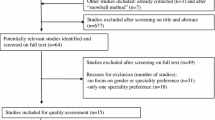Abstract
Prior research examining gender bias in textbooks used by medical students demonstrated that male models are used significantly more often than female models, raising concerns about the messages conveyed to trainees about patient care. By using a similar paradigm, this study assessed introductory psychiatric texts for gender bias. Five texts were selected for their use by medical students and based upon the presence of illustrative case vignettes. Frequencies with which vignettes featured male or female subjects were obtained. Two earlier versions of the DSM Casebooks were also reviewed for comparison with the most recent edition, to look for longitudinal trends. Male subjects were featured in case vignettes significantly more often than female subjects in the five texts combined; significantly different gender disparities were obtained in three of the five texts examined. The number of vignettes featuring female subjects exceeded those featuring males in one text. Despite repeated revision, each of the three versions of the DSM Casebooks retained a statistically significant predominance of male subjects. The observed gender discrepancies were not an artifact of use of vignettes illustrating disorders with higher prevalence rates among men. In fact, women were featured as subjects in vignettes illustrating disorders with higher prevalence rates among women. The use of predominantly male subjects was incongruent with trends in psychiatric service utilization by men and women. The potential impact of gender bias on medical trainees is discussed.
Similar content being viewed by others
References
Giacomini M, Rozee-Koker P, Pepitone-Arreola-Rockwell F: Gender bias in human anatomy textbook illustrations. Psychology of Women Quarterly 1986; 10:413–420
Howell MC: What medical schools teach about women. N Engl J Med 1974; 291:304–307
Mendelsohn KD, Nieman LZ, Isaacs K, et al: Sex and gender bias in anatomy and physical diagnosis text illustrations. JAMA 1994; 272:1267–1270
Nechas E, Foley D. Unequal Treatment: What You Don’t Know About How Women Are Mistreated by the Medical Community. New York, Simon & Schuster, 1994, pp. 41–14
Scully D, Bart P: A funny thing happened on the way to the orifice: women in gynecology textbooks. Am J Sociol 1973; 78:283–287
Scott KP, Schau CG: Sex equity and sex bias in instructional materials, in Handbook for Achieving Sex Equity Through Education, edited by Klein SS. Baltimore, MD, The Johns Hopkins University Press, 1985, pp. 218–232
Guttentag M, Guttentag B: Undoing Sex Stereotypes: Research and Resources for Educators. New York, McGraw-Hill, 1976, pp. 98–99
Rose C: New Directions for Higher Education: Meeting Women’s New Educational Needs. San Franciso, CA, Jossey-Bass, 1975, pp. 5–12
Knell S, Winer GA: Effects of reading content on occupational sex role stereotypes. Journal of Vocational Behavior 1979; 14:78–87
Nilsen AP, Bosmajian H, Gershuny HL, et al: Sexism and Language. Urbana, IL, National Council of Teachers of English, 1977
Yanico BJ: Sex bias in career information: effects of language on attitudes. Journal of Vocational Behavior 1978; 13:26–34
Minority Health Improvement Act of 1994, House of Representatives Report 103–501, May 11, 1994, Section 604, pp. 51–52
Andreasen NC, Black DW: Introductory Textbook of Psychiatry, 2nd Edition. Washington, DC, American Psychiatric Press, Inc., 1995
Goldman HH. Review of General Psychiatry, 4th Edition. East Norwalk, CT, Appleton and Lange, 1995
Pies RW: Clinical Manual of Psychiatric Diagnosis and Treatment—A Biopsychosocial Approach. Washington, DC, American Psychiatric Press, Inc., 1994
Spitzer RL, Gibbon M, Skodol AE, et al: DSM-IV Casebook—A Learning Companion to the Diagnostic and Statistical Manual of Mental Disorders, 4th Edition. Washington, DC, American Psychiatric Press, Inc., 1994
Stoudemire A: Clinical Psychiatry for Medical Students, 2nd Edition. Philadelphia, PA, JB Lippincott, 1994
Spitzer RL, Skodol AE, Gibbon M, et al: Diagnostic and Statistical Manual of Mental Disorders Case Book, 1st Edition. Washington, DC, American Psychiatric Association, 1981
Spitzer RL, Gibbon M, Skodol AE, et al: DSM-III-R Diagnostic and Statistical Manual of Mental Disorders Casebook, Revised Edition. Washington, DC, American Psychiatric Press, Inc., 1989
Weissman MM, Klerman GL: Sex differences and the epidemiology of depression. Arch Gen Psychiatry 1977; 34:98–111
Denmark F, Russo NF, Frieze IH, et al: Guidelines for avoiding sexism in psychological research: a report of the Ad Hoc Committee on Nonsexist Research. Am Psychol 1998; 43:582–585
Gannon L, Luchetta T, Rhodes K, et al: Sex bias in psychological research: progress or complacency? Am Psychol 1992; 47:389–396
Lennane KJ, Lennane RJ: Alleged psychogenic disorders in women—a possible manifestation of sexual prejudice. N Engl J Med 1973; 288:288–292
Council on Ethical and Judicial Affairs, American Medical Association: Gender disparities in clinical decision making. JAMA 1991; 266:559–562
Armitage KJ, Schneiderman LF, Bass RA: Response of physicians to medical complaints in men and women. JAMA 1979; 241:2186–2187
Bernstein B, Kane R: Physicians’ attitudes toward female patients. Med Care 1981; 19:600–608
Broverman IK, Broverman DM, Clarkson FE, et al: Sex-role stereotypes and clinical judgments of mental health. J Consult Clin Psychol 1970; 34:1–7
Tobin JN, Wassertheil-Smoller S, Wexler JP, et al: Sex bias in considering coronary bypass surgery. Ann Intern Med 1987; 107:19–25
Mendelsohn RS: Male Practice: How Doctors Manipulate Women. Chicago, IL, Contemporary Books, 1981
Cotton P: Examples abound of gaps in medical knowledge because of groups excluded from scientific study. JAMA 1990; 263:1051–1055
Cotton P: Is there still too much extrapolation from data on middle-aged white men? JAMA 1990; 263:1049–1050
Author information
Authors and Affiliations
Rights and permissions
About this article
Cite this article
Leo, R.J., Cartagena, M.T. Gender Bias in Psychiatric Texts. Acad Psychiatry 23, 71–76 (1999). https://doi.org/10.1007/BF03354245
Published:
Issue Date:
DOI: https://doi.org/10.1007/BF03354245




